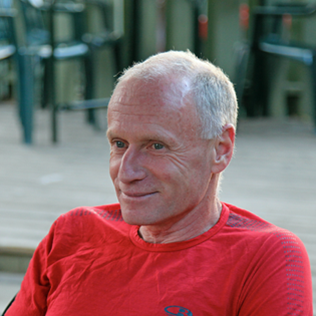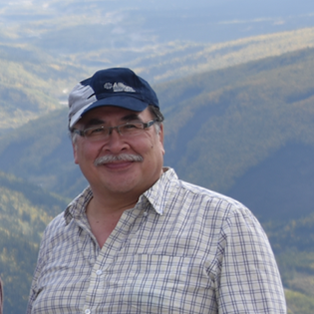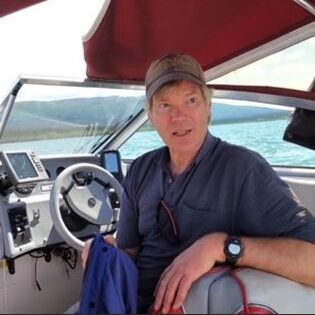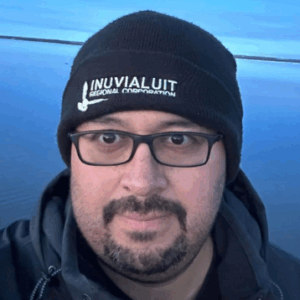About Us
Overview
The Environmental Impact Screening Committee (“EISC” or the “Committee”) has seven permanent members. The Chair is appointed by the Government of Canada with the consent of the Inuvialuit Game Council (“IGC”). The governments of Canada, the Yukon and the Northwest Territories each designate one member and Canada appoints these designated members (whom are referred to as the “Canada”, “Yukon”, and “GNWT” members). The IGC also appoints three “Inuvialuit” members.
The EISC mandate is derived from the Inuvialuit Final Agreement (“IFA”), section 11(36), which states that “no licence or approval shall be issued that would have the effect of permitting any proposed development to proceed unless the provisions of IFA section 11(36) have been complied with”. This compliance has the effect of requiring competent authorities to give notice of applications for licences, permits, or other authorizations, to the EISC. All applications for proposed development / research purposes must therefore be reviewed by the EISC to determine if they are to be subject to an Environmental Impact Screening (“EIS”).
If the proposed development could have a significant negative environmental impact on the ISR, or a significant negative impact on present or future Inuvialuit wildlife harvesting, the Committee can recommend terms and conditions to mitigate the potential impact(s), or make a decision that the project is subject to a further assessment and review by either the Environmental Impact Review Board (“EIRB”) or another competent body.
Since the Committee was established in 1986, over 700 development proposals have been screened. These projects have ranged from oil and gas, seismic and drilling programs, to cruise ships and other large development projects like the Inuvik-Tuktoyaktuk Highway (“ITH”). A standardized system for screening, developed by the Committee, has led to prompt and consistent decision-making. Through the efforts of the Screening Committee, a positive relationship between the Inuvialuit, industry, government, and the EISC has emerged.
Committee Members

EISC Chair
David Livingstone – Yellowknife, NT
David Livingstone was first appointed chair of the Environmental Impact Screening Committee in August 2017. David has worked in the north for over forty-five years and has made Yellowknife his home since 1987. Since his retirement from the federal government in 2009, David has independently engaged in a wide range of environmental stewardship projects in the NWT, Nunavut and internationally. In addition to his role on the EISC, until recently David chaired the Wilfrid Laurier University-ENR Science Committee, was a director and chair of the Giant Mine Oversight Board, worked with the Nunavut Planning Commission, and continues to provide strategic and policy advice to a range of partners and clients, mainly on environmental matters. David’s current term expires October 30, 2026.
GNWT Member
This position is currently vacant until the Government of the Northwest Territories designates someone and Canada appoints this person.

Inuvialuit Member
Darin Nasogaluak – Sachs Harbour, NT
Darin Nasogaluak has served as a member of the EISC for nearly a decade as well as on various other co-management boards. He is an experienced harvester and trapper who has lived in many parts of the Region (Tuktoyaktuk, Inuvik, and Sachs Harbor). His understanding of the important areas for wildlife and waterfowl provides valuable input on how developments make impact to such areas and on Inuvialuit harvesting rights. Darin’s current term expires September 30, 2027.

Inuvialuit Member
Raymond Ruben – Paulatuk, NT
As a family harvester and provider, Ray has always been very much involved with the local organizations and activities of his community. His interests also extend to the rest of the Inuvialuit Settlement Region. Ray is currently the Mayor of Paulatuk but is also the president of the Paulatuk Hunters and Trappers Committee, a director on the Anguniaqvia Niqiqyuam Marine Protected Area (ANMPA) working group and the Tuktut Nogait National Park Management Board (TNNPMB). Ray’s current term expires September 30, 2028.

Yukon Member
Bengt Pettersson – Whitehorse, YT
Bengt has more than 40 years’ experience in environmental and resource management, and in environmental and socio-economic assessments. Of those years, he has more than 20 years in senior management positions. He has worked in private sector consulting firms, governments, and crown corporations and boards. Bengt has been with the EISC since 2016, and his term expires on August 4, 2028.

Canada Member
Todd Slack – Yellowknife, NT
Todd Slack was appointed as the EISC Canada member in August 2019 and has been reappointed in 2022 and 2025. His current term expires August 23, 2028. Todd has a long history with EISC. In 2000, the Joint Secretariat hired him to work his first job following University and College. It was a classic northern story – moving from Ontario to the real north on a 6-month contract, making maps for EISC, EIRB and whomever else needed it. After 5 years in Inuvik, job opportunities in Yellowknife lured him south where he currently resides. After 15 years working for the government across the territory, he opened his own business providing regulatory and environmental support. He currently splits his time 60/40 between work and family, focusing on raising his young son.

Inuvialuit Member
Vernon Amos – Inuvik, NT
Originally from Sachs Harbor, Vernon now lives in Inuvik, NT (when he’s not at his cabin). Vernon Amos was previously the Chair of the Inuvialuit Game Council (2018-2020) and served on the Council for many years. Vernon’s unique skillset and viewpoint in interpreting and processing environmental issues comes from both his traditional knowledge and education at the University of Lethbridge where he studied Environmental Science. He also works at the National Indigenous Fisheries Institute. Vernon’s current term expires September 30, 2027.
Your filters yielded no results.
EISC Staff
The EISC hires a Resource Coordinator to help fulfill its mandate, this position is currently filled by Patricia Sung.

EISC Coordinator
Patricia Sung – Inuvik, NT
Patricia Sung grew up in Hawaii but moved to Canada where she obtained a Bachelor of Science in Honours Environment – Biodiversity and Conservation with a minor in GIS and Remote Sensing from McGill University. Patricia has 5+ years of coordinator related experience and 2+ years of experience working for and with northern Indigenous organizations (Makivvik and Inuvialuit Game Council through Joint Secretariat) doing resource and wildlife management, arctic fieldwork, and remote-sensing based research. In 2025, Patricia was hired by the Joint Secretariat to fill the role of Coordinator for the EISC. Outside of work, Patricia loves to try new things. From woodwork and welding, to beadwork, or cooking. Patricia is excited to get involved and learn from the communities!
Your filters yielded no results.
Appointments
Under IFA section 11(5) The EISC is made up of seven (7) permanent members: a chair and six (6) members.
The three (3) Inuvialuit members are appointed by the Inuvialuit Game Council (“IGC”) while the governments of Canada, the Yukon and the Northwest Territories each designate one member to the EISC.
The chair of the EISC is appointed by the Federal Government of Canada with the consent of the Inuvialuit. In cases where the parties cannot agree on the chair, the Chief Justice of either Territories may appoint a chair at the request of a party. All terms served on the EISC are for three (3) years.
The process to be appointed as committee member for the EISC is outlined for each of the appointment bodies below:
Inuvialuit Members (Nominated by HTCs appointed by IGC):
The three (3) Inuvialuit members are appointed by the Inuvialuit Game Council (“IGC”). If the EISC has an open position for an Inuvialuit Member, an interested individual needs to be nominated by two (2) members of their representative Hunters and Trappers Committee (“HTC”). These applications are then considered by the IGC at their quarterly meeting in September, where they decide who should be appointed to the committee.
GNWT Member (Nominated by the Government of the Northwest Territories, appointed by the Government of Canada):
To be nominated for the EISC as the GNWT member, when a vacancy arises, an application must be submitted on the NWT Public Committees, Boards and Councils website.
Yukon Member (Nominated by the Yukon Government, appointed by the Government of Canada):
To be nominated for the EISC as the Yukon member, when a vacancy arises, an application is submitted to the appropriate individual as can be found on the Yukon Government Boards and Committees website.
Canada Member (Nominated and appointed by the Government of Canada):
To be nominated for the EISC as the Canada member, when a vacancy arises, a letter and resume is sent to the NT Board Relations department of Crown-Indigenous Relations and Northern Affairs Canada.
Frequently Asked Questions
Proponents & Developers
What is the environmental impact screening and review process?The Environmental Impact Screening and Review Process is a formal process established by the Inuvialuit Final Agreement (IFA) to identify and assess the potential environmental and harvesting impacts of proposed developments in the Inuvialuit Settlement Region (ISR). The process is designed to ensure that development activities are conducted in a manner that is consistent with the principles of sustainable development and with the rights and interests of the Inuvialuit.
What is a development?If the project that is being proposed within the Inuvialuit Settlement Region meets the definition of development, as set out in the Inuvialuit Final Agreement it is a development and will normally be subject to screening:
- any commercial or industrial undertaking or venture, including support and transportation facilities related to the extraction of non-renewable resources from the Beaufort Sea, other than commercial wildlife harvesting; or
- any government project, undertaking or construction whether federal, territorial, provincial, municipal, local or by any Crown agency or corporation, except government projects within the limits of Inuvialuit communities not directly affecting wildlife resources outside those limits and except government wildlife enhancement projects.
Common developments reviewed by the EISC include:
- Cruise Ships
- Mining Exploration
- Tourism
- Research
- Reclamation
- Repair
- Decommissioning
- Seismic
- Construction
- Monitoring
- Maintenance
- Remediation
- Oil and Gas
- Geophysical
- Modification
Do I need to submit to the EISC?If you are planning to do an activity within the Inuvialuit Settlement Region and it is done by a commercial or governmental organization that requires licencing, you will be required to submit to the EISC.
How do I submit to the EISC?To submit to the EISC you can contact the EISC Resource Person (eisc@jointsec.nt.ca) and ask to have your EISC Registry account linked to your project’s organization. After this is completed, you will be able to fill out the EISC’s Pre-Screening Questionnaire on the EISC Registry starting your project submission.
What are valued components?Valued components (“VCs”) refer to specific environmental, cultural, and socio-economic factors that are important and valued within the ISR. These components are defined by the proponent in their submission to the EISC.
What are cumulative impacts?Cumulative impacts refer to the combined effects of multiple developments and activities on the environment, wildlife, and communities over time. The EISC considers the cumulative impacts when assessing the potential effects of a proposed project.
Do all projects submitted to the EISC go through screening?No, some projects may be exempt from the screening process if they do not meet the definition of a development, or they fall under specific categories listed in the exclusion list outlined in Appendix A of the EISC Guidelines.
How long does the environmental impact screening process take?The environmental impact screening process usually takes between seven (7) to sixty-five (65) days after verification that it is complete, depending on the proponent’s response times and whether the project goes through screening. Pre-screening and Screening may take longer in some circumstances.
What does a recommendation look like?A recommendation from the EISC may include specific terms and conditions that the proponent should adhere to mitigate potential impacts or to ensure compliance with environmental requirements and regulations. It should be noted that the EISC only provides recommendations on projects that undergo screening and result in a 11(17)(b) decision. A recommendation given on a filming project occurring on in Ivvavik National Park [03/23-14] can be found below:
Preamble
The Proponent identified in section 6.0 of the submitted project description that a wildlife monitor would be hired from Aklavik at the recommendation of the Aklavik Hunters and Trappers Committee.Recommendation
The Proponent shall contact the Aklavik Hunters and Trappers Committee to hire an appropriate and skilled wildlife monitor who has successfully completed bear safety training.How do I know which Hunters and Trappers Committee to contact?Using the Community Conservations Plans (“CCPs”) you can find where each community has their land categories designated, if you fall under one of these land categories you need to contact the appropriate Hunters and Trappers Committee (“HTCs”). Contact information can be found here.
How should developers approach cumulative impact assessment?Developers should approach cumulative impact assessment by considering the potential combined effects of their project along with other existing and planned developments in the area. They should conduct a thorough assessment of the cumulative impacts on the environment, wildlife, and communities. This assessment should include consultation with relevant stakeholders, collaboration with other developers, and the incorporation of best practices and guidelines for cumulative impact assessment.
Interested Parties
How do I submit comments and information requests?During the commenting period, stakeholders and interested parties can submit written comments and information requests to the EISC. These can be sent via email to eisc@jointsec.nt.ca or uploaded directly to the registry file of a given project on the EISC Registry.
How can I stay informed about projects occurring in the Inuvialuit Settlement Region?You can stay informed about projects by regularly checking the public registry of the EISC, attending public presentations or hearings, and signing up for notifications found on the EISC registry site. More information can be found here.
Where can I find more detailed information about the EISC’s process?You can find more detailed information about the EISC’s process in the EISC Guidelines, which provide comprehensive guidance on the screening process, requirements, and procedures. These guidelines are here.
General
What is the IFA?The IFA stands for the Inuvialuit Final Agreement. It is a legal agreement signed in 1984 between the Committee for Original Peoples Entitlement on behalf of the Inuvialuit and the Government of Canada. The IFA sets out the rules for land, wildlife, and economic development management in the Inuvialuit Settlement Region.
Are there other environmental assessment bodies?Yes, the EISC works with several other assessment bodies found in the north including the Mackenzie Valley Environmental Impact Review Board, the Yukon Environmental and Socio-economic Assessment Board (“YESAB”), and the Nunavut Impact Review Board (“NIRB”).
What is the record?The record refers to the collection of documents, information, and correspondence related to a specific project that is submitted to the EISC and becomes part of the official record for that project.
What are transboundary concerns?Transboundary concerns refer to potential impacts of a project or development that extend beyond the boundaries of the area it is being screened in. If there are transboundary concerns, the EISC may screen developments occurring outside their jurisdiction. They can also screen developments in neighbouring areas at the request of the Dene/Métis and the Inuvialuit.
Who are the committee members of the EISC?The EISC consists of seven permanent members, including the chair. Three members are appointed by the Inuvialuit, and three members are appointed by Canada. The chair is appointed by Canada with the consent of the Inuvialuit. The current members and bios can be found here.
Would a project ever need to go through screening twice?If a project undergoes significant changes, the EISC may require the proponent to resubmit the project description (“PD”) and undergo screening again. Multi-year and ongoing projects may need to submit to the EISC once a year for a renewal.
Are there any specific rules for oil and gas companies?The EISC does not have specific rules tailored exclusively for oil and gas companies. Oil and gas projects are subject to the same screening process as other types of developments. The EISC evaluates their potential environmental impacts and determines whether they could have a significant negative impact.
Is research considered a development?Research projects can be considered developments if they meet the definition outlined in the Inuvialuit Final Agreement (“IFA”). If a research project falls under the definition of a development, it may be subject to screening by the EISC to assess its potential environmental effects. Check the EISC Screening Guidelines for more information.
What are the Community Conservation Plans?The Community Conservation Plans (“CCPs”) describe the different community priorities when it comes to harvesting and land sensitivities. These plans are meant to provide guidance regarding the conservation and management of natural resources and lands within the ISR and can help developers with an interest in the planning area.
What is the Inuvialuit Game Council’s role in environmental assessment?The Inuvialuit Game Council (“IGC”) plays a significant role in wildlife management and conservation within the Inuvialuit Settlement Region (“ISR”). They represent the interests of the Inuvialuit regarding wildlife harvesting and environmental concerns. The IGC appoints members to the EISC and contributes to the decision-making process for environmental impact assessments.
What is the role of community consultation in the environmental impact screening and review process?Community consultation plays a crucial role in the Environmental Impact Screening and Review Process. Community consultation allows local communities to voice concerns, give input, and share knowledge during the assessment of proposed developments. The EISC considers the feedback received during public consultation when evaluating the potential impacts of a project and making recommendations.
More Questions
If your question isn’t listed above, please feel free to contact the EISC.
Contact Information
Patricia Sung
Coordinator, Environmental Impact Screening CommitteeTelephone: (867) 777-2828
Fax: (867) 777-2610
Email: eisc@jointsec.nt.caJoint Secretariat, Inuvialuit Settlement Region
P.O. Box 2120 – 76 Mackenzie Road X0E 0T0
Inuvik, Northwest Territories, Canada
